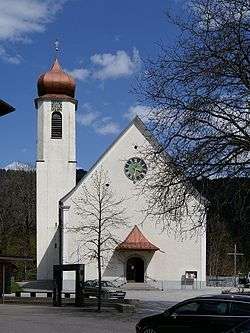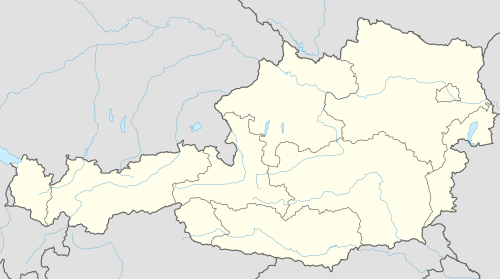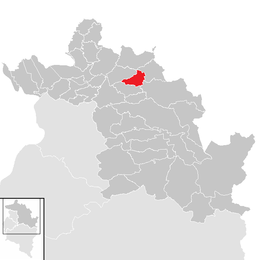Krumbach, Vorarlberg
| Krumbach | ||
|---|---|---|
 | ||
| ||
 Krumbach Location within Austria
Location in the district
| ||
| Coordinates: 47°28′59″N 09°56′09″E / 47.48306°N 9.93583°ECoordinates: 47°28′59″N 09°56′09″E / 47.48306°N 9.93583°E | ||
| Country | Austria | |
| State | Vorarlberg | |
| District | Bregenz | |
| Government | ||
| • Mayor | Arnold Hirschbühl | |
| Area | ||
| • Total | 8.71 km2 (3.36 sq mi) | |
| Elevation | 732 m (2,402 ft) | |
| Population (1 January 2016)[1] | ||
| • Total | 2,305 | |
| • Density | 260/km2 (690/sq mi) | |
| Time zone | UTC+1 (CET) | |
| • Summer (DST) | UTC+2 (CEST) | |
| Postal code | 6942 | |
| Area code | 05513 | |
| Vehicle registration | B | |
| Website | www.krumbach.at | |
Krumbach is a village in the Austrian state of Vorarlberg in the Bregenz district. The municipality has about 1000 inhabitants.
Geography
Krumbach stretches over an area of 8.71 km². It lies in the west of the country, more specifically in the Vorderwald which is part of the Bregenzerwald. Two rivers, the Weißach and the Bolgenach, flow through Krumbach. A special landscape feature of Krumbach are the numerous peat bogs.
Krumbach is a member of the German-Austrian community project Naturpark Nagelfluhkette.
Culture
The parish church Hl. Martin was built by local builders and consecrated in 1806. The church furnishing is partly baroque and partly baroquised from the 18th and 19th century.
The Giessen Bridge is a wooden bridge over the river Bolgenach that was built in 1792. Nowadays, the bridge is mainly used by walkers who wish to hike from Krumbach to Riefensberg.
Due to the renewal of the well in Krumbach in 1999, a "Dorfbrunnen" (the village well) was commissioned. The Bregenzerwälder artist Herbert Meusburger designed a well that represented a portal between the bourgeois and the ecclesiastic.
The Bregenzerwald Umgang (literally Bregenz forest walk) shows the design of 12 traditional villages, including Krumbach, in the Bregenz Forest. By means of the landscape, public buildings, houses and everyday objects, walkers are informed about the typical Bregenzerwälder architecture style throughout the centuries. The focus of the Bregenz forest walk in Krumbach is on the peat bogs.
Bus Stop Krumbach
Krumbach is known for its extraordinary bus stops, which are designed by seven international artists[2]. In 2014, the project received special recognition as part of the Austrian National Architecture Awards as well as the National Award for PR[3].
The city's central bus stop was redesign and renovated by local architects Bernardo Bader, René Bechter and Hermann Kaufmann. A new design, that aimed to shape the character of the village centre. Furthermore, new bus stops were necessary for the surrounding region and the project started with a rough idea about how to handle renovation works[4].
The association kultur krumbach asked international designers to create 7 small bus-shelters for the community with the prerequisite, that local craftspeople carry out the constructions. Therefore, 7 selected international architecture offices engaged with people, landscape, local culture of building and the tradition of skilled craftsmanship in the Bregenzerwald.
Around 300 people were finally involved and the bus stops were intended as reminder of the power of traditional materials, local craftsmanship, the beauty of the region as well as tradition and modernity and local culture.
International architects were:
- Alexander Brodsky (Russia)
- Rintala Eggertsson Architects (Norway)
- Architects de Vylder Vinck Taillieu (Belgium)
- Ensamble Studio Antón García-Abril (Spain)
- Smiljan Radic (Chile)
- Sou Fujimoto (Japan)
- Wang Shu (China).
Population
| Historical population | ||
|---|---|---|
| Year | Pop. | ±% |
| 1869 | 1,009 | — |
| 1880 | 944 | −6.4% |
| 1890 | 888 | −5.9% |
| 1900 | 792 | −10.8% |
| 1910 | 755 | −4.7% |
| 1923 | 708 | −6.2% |
| 1934 | 737 | +4.1% |
| 1939 | 651 | −11.7% |
| 1951 | 771 | +18.4% |
| 1961 | 759 | −1.6% |
| 1971 | 778 | +2.5% |
| 1981 | 836 | +7.5% |
| 1991 | 913 | +9.2% |
| 2001 | 933 | +2.2% |
| 2011 | 990 | +6.1% |
External links
References
- ↑ Statistik Austria - Bevölkerung zu Jahresbeginn 2002-2016 nach Gemeinden (Gebietsstand 1.1.2016) for Krumbach.
- ↑ "New Images Released of Krumbach, Austria's Famous Bus Stops". ArchDaily. 2014-08-05. Retrieved 2018-06-26.
- ↑ "Der Staatspreis PR 2014 geht an BUS:STOP Krumbach - PRVA Public Relations Verband Austria". prva.at (in German). Retrieved 2018-06-26.
- ↑ "Bus Stop Krumbach project description". Gemeinde Krumbach (in German). Retrieved 2018-06-26.
| Wikimedia Commons has media related to Krumbach (Vorarlberg). |

